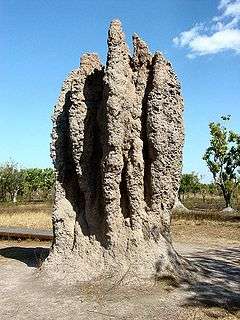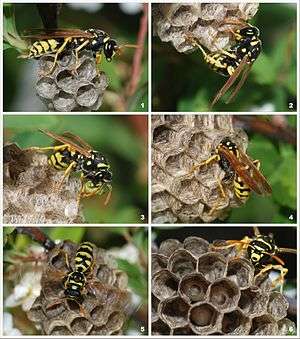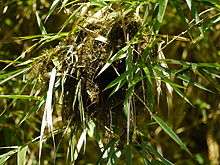Structures built by animals

Nature abounds with structures built by animals other than humans, or animal architecture,[1] as it is commonly termed, such as termite mounds, wasp and beehives, burrow complexes of rodents, beaver dams, elaborate nests of birds, and webs of spiders.
Often, these structures incorporate sophisticated features such as ventilation, temperature regulation, structural strength, multiple escape routes, traps, bait, special-purpose chambers and many other features. They may be created by individuals or complex societies of social animals with different forms carrying out specialised roles. These constructions may arise from complex building behaviour of animals such as in the case of night-time nests for chimpanzees,[2] from inbuilt neural responses, which feature prominently in the construction of bird songs, or triggered by hormone release as in the case of domestic sows,[3] or as emergent properties from simple instinctive responses and interactions, as exhibited by termites, or combinations of these.[4] The process of building such structures may involve learning and communication,[4] and in some cases, even aesthetics.[5] Tool use may also be involved in building structures by animals.[6]
Animals which build

Building behaviour is common in many non-human mammals, birds, insects and arachnids. It is also seen in a few species of fish, reptiles, amphibians, molluscs, urochordates, crustaceans, annelids and some other arthropods. It is virtually absent from all the other animal phyla.[6]
Functions
Animals create structures primarily for three reasons:[6]
- to create protected habitats, i.e. homes.
- to catch prey and for foraging, i.e. traps.
- for communication between members of the species (intra-specific communication), i.e. display.
Animals primarily build habitat for protection from extreme temperatures and from predation. Constructed structures raise physical problems which need to be resolved, such as humidity control or ventilation, which increases the complexity of the structure. Over time, through evolution, animals use shelters for other purposes such as reproduction, food storage, etc.[6]
Protection from predators


Predators are attracted to animal-built structures either by the prey or its offspring, or the stored caches of food. Structures built by animals may provide protection from predators through avoiding detection, by means such as camouflage and concealment, or through prevention of invasion, once predators have located the hideout or prey, or a combination of both.[6]:11 As a last resort, structures may provide means of escape.
Animals use the techniques of crypsis or camouflage, concealment, and mimicry, for avoiding detection.[6]:11 Crypsis works by blending the structure with its background. The use of lichen flakes as an outer covering of nests by birds, as in the case of the paradise flycatcher (Terpsiphone paradisei) have been considered by some authors to be a case of crypsis through "branch-matching" and as a case of disruptive camouflage by the British ethologist, M. Hansell, where the lichen flakes are thought to resemble small patches of light seen through as in the case of insubstantial objects of insufficient importance to receive a predator's interest.[6]:11, 12
Ground-nesting birds which rely on crypsis for concealment have nests made from local materials which blend in with the background, the eggs and young too are cryptic; whereas birds which do not use crypsis for hiding their nests may not have cryptic eggs or young.[7]
In a case apparently of masquerade, the red-faced spinetail Cranioleuca erythrops places bits of grass and other material loosely streaming both above and below the nest chamber to break the shape of the nest and to cause it to resemble random debris without any underlying structure.[8]
Thermoregulation

Temperature extremes harm animals irrespective of whether they are endothermic or ectothermic. In endothermic animals, construction of shelters, coupled with behavioural patterns, reduces the quantity and energy cost of thermoregulation, as in the case of the Arctic ground squirrels.[9]
In ectothermic animals, moderation of temperature, along with architectural modifications to absorb, trap or dissipate energy, maximises the rate of development, as in the case of the communal silk nests of the small eggar moth Eriogaster lanestris. The primary sources of energy for an animal are the sun and its metabolism. The dynamics of heat in animal shelters is influenced by the construction material which may act as a barrier, as a heat sink or to dissipate heat. The cocoons of insect are a case in point.
An interesting example is the case of silk caps which cover the pupal cells of the Oriental hornet Vespa orientalis. Firstly, the silk insulates the pupa from the air outside the cell, and secondly, it acts as a thermostatic regulator. By virtue of its thermoelectric properties, the silk stores excess daytime heat in the form of electric charge which it releases in the form of an electric current when the temperature falls resulting in heating. Cooling is aided by evaporation of excess water from the pupal cells. When the ambient temperature drops, the silk absorbs moisture and restores the moisture content by spreading water through all parts of its cocoon.[6]:2-4
Internal architectural devices, such as walls may block convection or the construction of air flow systems may cool the nest or habitat.
Building materials
Materials used by animals in building structures need to not only be suitable for the kind of structure to be built but also to be manipulable by the animals. These materials may be organic in nature or mineral. They may also be categorised as "collected material" and "self-secreted material".[10]
Collected materials

Some animals collect materials with plastic properties which are used to construct and shape the nest. These include resin collected by stingless bees, mud collected by swallows and silk collected by hummingbirds.[10]
Some materials in nature act as ready made "building blocks" to the animals in question, such as feathers and leaf petioles for some birds and animal hair for the chaffinch. Other materials need to be "processed". Caddisfly larvae use stone pieces and also cut sections from green leaves for use in construction. The stone pieces are selected as per their size and shape from a large variety. In the case of leaf sections, these are cut and shaped to required size. Similarly bagworms cut and shape thorns or twigs to form their case.[10] Some sphecid wasps collect mud and blend them with water to construct free standing nests of mud.[11] Paper wasp queens build with paper pulp which they prepare by rasping wood with their jaws and mixing with saliva, a case of collecting, processing and blending raw materials.[12]
An animal builder may collect a variety of materials and use them in complex ways to form useful habitat. The nest of the long-tailed tit, Aegithalos caudatus, is constructed from four materials – lichen, feathers, spider egg cocoons and moss, over 6000 pieces in all for a typical nest. The nest is a flexible sac with a small, round entrance on top, suspended low in a gorse or bramble bush. The structural stability of the nest is provided by a mesh of moss and spider silk. The tiny leaves of the moss act as hooks and the spider silk of egg cocoons provides the loops; thus forming a natural form of velcro.[13] The tit lines the outside with hundreds of flakes of pale lichens – this provides camouflage. Inside, it lines the nest with more than 2000 feathers to insulate the nest.[13]
About the construction of nest by the long-tailed tit, it has been written:
"...the most amazing thing about it (the building behaviour) is, in my opinion that so few, so simple and so rigid movements together lead to the construction of so superb a result."
Niko Tinbergen, 1953.[13]
Material of animal origin
Birds form the majority of the group of animals which collect building material of animal origin. They collect animal fur and feathers of other species of birds to line their nests. Almost 56% of all families of passerine birds have species which utilise spider silk. Most birds use spider silk as in the case of the long-tailed tit, previously discussed; however the little spiderhunter (Arachnothera longirostra) of Asian tropical forests uses spider silk differently. It constructs a nest of plant strips which it suspends below a large leaf using spider silk for about a 150 or so of "pop-rivets".[14]
Plant material

Flowering plants provide a variety of resources – twigs, leaves, petioles, roots, flowers and seeds. Basal plants, such as fungi, lichens, mosses and ferns also find use in structures built by animals. The leaves of grasses and palms being elongate and parallel-veined are very commonly used for building. These, along-with palm fibers and horse-hair fern are used to build hanging baskets. Wooden twigs form the greater proportion of materials used in the nests of large birds. Plants and trees not only provide resources but also sites. Branches provide support in the form of cantilevered beams while leaves and green twigs provide flexible but strong supports.[10]
Mud and stones
Mud is used by a few species of a wide variety of families including wasps and birds. Mud is plastic when wet and provides compressive strength when dried. Amongst birds, 5% of all birds use mud and stones in their nest for toughness and compressive strength.[10]
Self-secreted materials
.jpg)
The majority of self-secreted materials are produced by insects and selection acts on this characteristic of production of self-secreting materials and increases the fitness of the animal. In some cases, the self-secreted material is directly applied, as in the case of ecribellate silk, spun by ecribellate spiders, to form sticky traps for prey, or it may be processed, as in the case of salivary excretion used for creation of paper by paper wasps, by blending it directly with wood pulp. Self-secreted materials may be processed in some cases. In cribellate spiders, silk produced by the spider are reworked in the cribellum to form fine sticky strands used for capturing prey.[15] In other cases, the scale wax, produced on the bodies of honey bees, is gathered and blended with saliva, to form comb wax, the building material.[15] Not all self-secreted materials are developed specifically for that purpose. For example, bird feathers are used for lining and insulation, a typical example being that of the female common eider duck (Somateria mollissima), which produces down feathers for lining its nest.[10]
See also
References
- ↑ Mandal, Fatik Baran (1 January 2010). Textbook of animal behaviour. PHI Learning Pvt. Ltd. p. 100. ISBN 978-81-203-4035-0. Retrieved 29 June 2011.
- ↑ Wrangham, Richard W. (1996). Chimpanzee cultures. Chicago Academy of Sciences, Harvard University Press. p. 115. ISBN 978-0-674-11663-4. Retrieved 2 July 2011.
- ↑ A.; L. (2009). "Behaviour and physiology". In Jensen, Per. The ethology of domestic animals: an introductory text. CABI. p. 34. ISBN 978-1-84593-536-8. Retrieved 10 July 2011.
- 1 2 Gould, James L.; Gould, Carol Grant (12 March 2007). Animal architects: building and the evolution of intelligence. Basic Books. pp. 1–18. ISBN 978-0-465-02782-8. Retrieved 1 July 2011.
- ↑ Frith, Clifford B.; Frith, Dawn W.; Barnes, Eustace (2004). The bowerbirds: Ptilonorhychidae. Oxford University Press. p. 12. ISBN 978-0-19-854844-7. Retrieved 1 July 2011.
- 1 2 3 4 5 6 7 8 Michael Henry Hansell (2005). Animal architecture. Oxford University Press. pp. 1–2. ISBN 978-0-19-850752-9. Retrieved 29 June 2011.
- ↑ Götmark, F. (1993). "Conspicuous nests may select for non-cryptic eggs: a comparative study of avian families". Ornis Fenn. 70: 102–105.
- ↑ Hansell, Michael Henry (2000). Bird nests and construction behaviour. Cambridge University Press. p. 103. ISBN 978-0-521-46038-5. Retrieved 10 August 2011.
- ↑ Vaughan, Terry A.; Ryan, James M.; Czaplewski, Nicholas J. (15 February 2010). Mammalogy. Jones & Bartlett Learning. pp. 440–441. ISBN 978-0-7637-6299-5. Retrieved 10 July 2011.
- 1 2 3 4 5 6 Hansell, M. (2005). Pp 35–54.
- ↑ Bohart, Richard Mitchell; Menke, Arnold S. (1976). Sphecid wasps of the world: a generic revision. University of California Press. p. 2. ISBN 978-0-520-02318-5. Retrieved 1 July 2011.
- ↑ Burton, Maurice; Burton, Robert (1970). The international wildlife encyclopedia. Marshall Cavendish. p. 1864. ISBN 978-0-7614-7266-7. Retrieved 1 July 2011.
- 1 2 3 Hansell, Michael Henry (2007). Built by animals: the natural history of animal architecture. Oxford University Press. pp. 76, 77. ISBN 978-0-19-920556-1. Retrieved 1 July 2011.
- ↑ Hansell (2007), pp 19–21.
- 1 2 Capinera, John L. (17 September 2008). Encyclopedia of entomology. Springer. pp. 3495–3496. ISBN 978-1-4020-6242-1. Retrieved 2 July 2011.